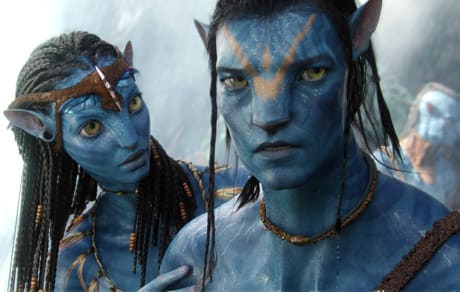Director James Cameron once declared himself "king of the world"; now he's become a creator of worlds, in particularly, Pandora, the lush, majestic site of his latest monster blockbuster, Avatar. In Pandora, everything that's awe-inspiring and breathtaking about Cameron's unique ambitions is brought to life; its lush jungles are brimming with unusual foliage and creatures great and small; its cloud-covered mountains literally hang in mid-air; even its native inhabitants - the ten-foot-tall, blue-skinned Na'vi - rival LOTR's Golem in their visceral, albeit digitally created, realness.
The Na'vi are the heart of Cameron's story: in a space-exploring human future, Pandora is discovered to be home to an invaluable mineral (absurdly and meaninglessly called "unobtantium"); naturally, its extraction is best done by white men via brutal, life-destroying means. Almost as an aside, sensitive scientists like Sigourney Weaver are developing mind-meld technology that allows people to operate Na'vi versions of themselves out in Pandora's human-toxic environment, becoming the ultimate spies. In his presentations of both the mining base and the Na'vi home worlds, Cameron demonstrates his meticulous attention to insane detail, brought to life all the more by the innovations he's shepherded in 3D technology. This is the third time that Cameron has pushed the envelope of the most expensive movie ever made (after Terminator 2 and Titanic ― Avatar's reported price tag exceeds $500 million), and you can't deny he gives better ― and more coherent (ahem, Michael Bay) ― bang for the technological buck than anyone.
So, Avatar looks stunning, lush, beautiful and breathtaking. Narratively, it's Dances With Aliens ― Jake Sully (Terminator: Salvation's Sam Worthington) gets embedded with the Na'vi, falls in love, gets convinced of the horrors of the "Western" forces he represents and decides to do what's morally "right." Military and corporate interests are evil (a common Cameron trope, in this case embodied by a business stooge played by Giovanni Ribisi and a hardened soldier, Stephen Lang), while native cultures should be honoured and left alone. It's just a hair shy of a mustachioed Kevin Costner riding through on a space-steed. But as much as one might groan at you're-kidding-me dialogue like "we're not in Kansas any more," Cameron immediately shows just what "not Kansas" looks like in his vision. And it's truly spectacular, a game-changing achievement in filmmaking and particularly in production design, character creation and visual effects. Next time, spend a half-mil or so on another script pass.
(20th Century Studios)The Na'vi are the heart of Cameron's story: in a space-exploring human future, Pandora is discovered to be home to an invaluable mineral (absurdly and meaninglessly called "unobtantium"); naturally, its extraction is best done by white men via brutal, life-destroying means. Almost as an aside, sensitive scientists like Sigourney Weaver are developing mind-meld technology that allows people to operate Na'vi versions of themselves out in Pandora's human-toxic environment, becoming the ultimate spies. In his presentations of both the mining base and the Na'vi home worlds, Cameron demonstrates his meticulous attention to insane detail, brought to life all the more by the innovations he's shepherded in 3D technology. This is the third time that Cameron has pushed the envelope of the most expensive movie ever made (after Terminator 2 and Titanic ― Avatar's reported price tag exceeds $500 million), and you can't deny he gives better ― and more coherent (ahem, Michael Bay) ― bang for the technological buck than anyone.
So, Avatar looks stunning, lush, beautiful and breathtaking. Narratively, it's Dances With Aliens ― Jake Sully (Terminator: Salvation's Sam Worthington) gets embedded with the Na'vi, falls in love, gets convinced of the horrors of the "Western" forces he represents and decides to do what's morally "right." Military and corporate interests are evil (a common Cameron trope, in this case embodied by a business stooge played by Giovanni Ribisi and a hardened soldier, Stephen Lang), while native cultures should be honoured and left alone. It's just a hair shy of a mustachioed Kevin Costner riding through on a space-steed. But as much as one might groan at you're-kidding-me dialogue like "we're not in Kansas any more," Cameron immediately shows just what "not Kansas" looks like in his vision. And it's truly spectacular, a game-changing achievement in filmmaking and particularly in production design, character creation and visual effects. Next time, spend a half-mil or so on another script pass.
